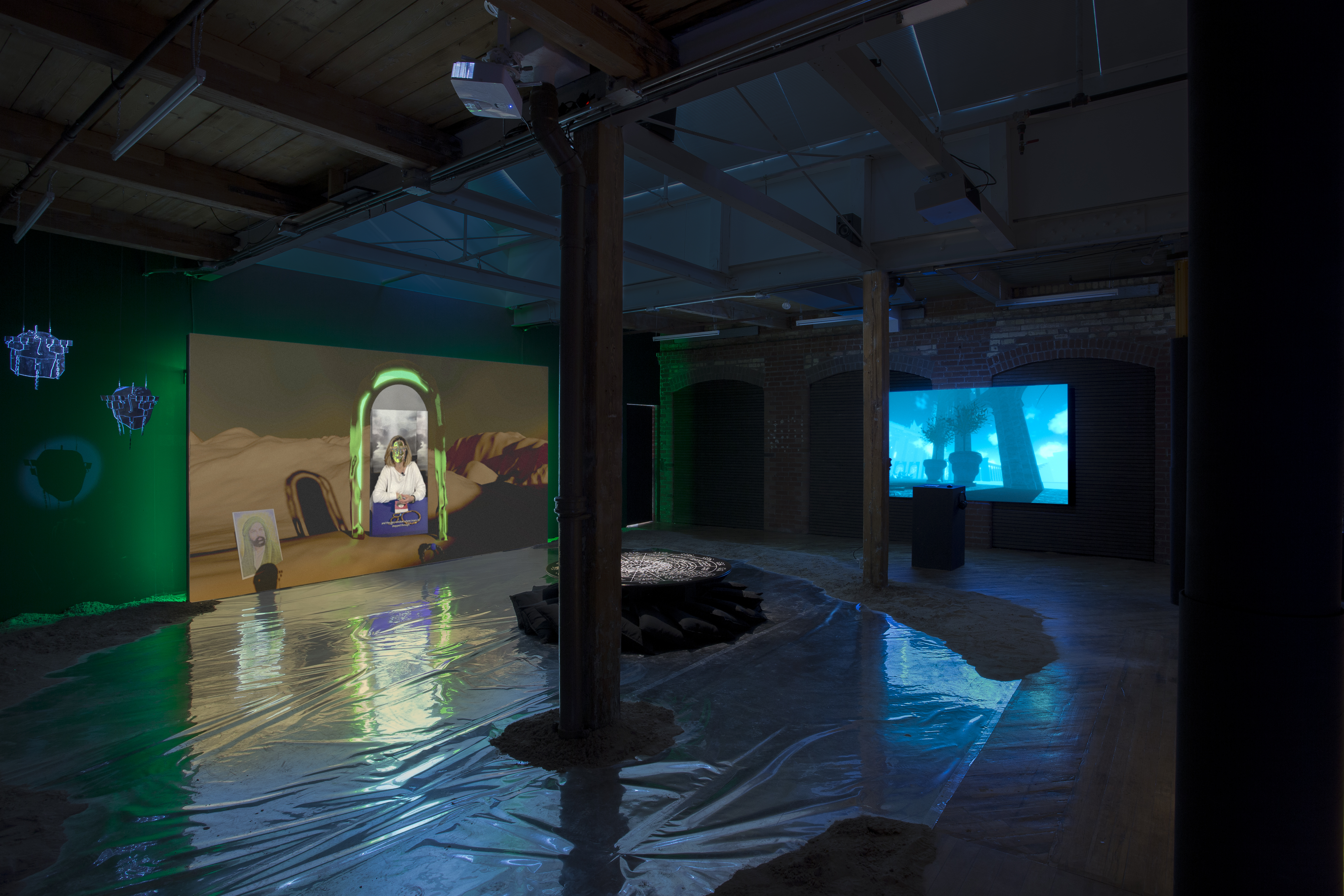Spectral Futures: Exhibition Essay
PDF/PRINT VERSION WITH POEM
By Nazanin Zarepour
15 March 2024
SPECTRAL FUTURES is an exhibition at Trinity Square Video running from February 22 to March 30, 2023. Curated by Vince Rozario, this exhibition brings together the digital media practices of Jawa El Khash and Shirin Fahimi, which confront the absence of queer, feminist and otherwise marginalized narratives within dominant histories.


What do we seek when we look toward the
past? In the face of capital-induced displacement, the trope of “Uprooted Artist” has
emerged as an effective depoliticizing bind –
trapping our glances at history in a perpetual state
of grief and longing. The Uprooted Artist is born,
in part, out of a desire for a miracle – that one can
somehow synthesize the contradictions between
present lives and ones “left behind.” The resulting
cultural production often traps itself in the stillness
of memory, waxing narratives that cannot account
for transformation, dynamic shifts, changes in absence. This urge to self-ethnographize would not
be possible, however, without an external push.
The Uprooted Artist is expected to “perform the
function of native informant”, to represent, and
therefore, calcify trauma and history for the colonial viewer.1 Caught in the trappings of back-home
platitudes and self-deluded authenticity fables, how
might we relocate liberation and dynamism in the
telling of our histories?
Liberation ideologies of 20th century West Asia
in the age of decolonization offer an alternative.
From the traditions of Arab existentialism to the liberation theologies of the Iranian Revolution, intellectuals made an urgent call for a re-imagination of
the “Self” in relation to the colonial “Other.”2 Iranian intellectual Ali Shari’ati, for instance, articulated
the self through an invitation to take a fresh glance
at our history.3 In articulating history, one must not
be concerned with “accurate” representations of the
past, nor seek a pure native past outside of empire.
This is not to propose the manufacturing of facts
but rather that a neutral view of history in itself is a
fantasy. One must instead look to the past with the
intention of locating new meaning and avenues of
emancipation for our present and future – to refashion our idioms for political action.
In negating “authentic” re-telling, Spectral Futures provokes a fresh glance and re-articulation of
our past, and thus offering a disruption to our present. In the latest iteration of colonial-preservation efforts, VR and new media technologies have become
critical in attempts to produce so-called “accurate
representations” of real-world counterparts.4 The
immersive, and in turn, depoliticizing function of
these technologies manufacture landscapes where
one can step into mystic pasts separated from present, lived reality. Jawa El Khash and Shirin Fahimi
challenge the hegemonic implications of new imaging technologies to invite fresh glances at our histories that remain inextricably linked to both present
and future materiality. In continuous confrontation
with sand, earth, the rough edges of the technology
being used, the fallibility of rendered images, Spectral Futures urges us to keep our feet on the ground.
Thus, the re-animation of ancestral memories of
displacement and colonization do not invite disembodied grief, but are a beckoning call to ground our
struggles in the present and in the land.
In
Upper Side of the Sky, El Khash takes up the
question of preservation by re-imagining Palmyra,
Syria—a landscape that has been especially subject
to centuries-long colonial obsession. Collaged within a thick mist lie the ruins of Palmyra’s Arch of Triumph, the Roman Theatre, and the Temple of Bel,
all of which were subject to Daesh’s destruction in
2015. This devastating act of iconoclasm was met
with outrage from the West, born out of what can
only be deemed a sense of “first dibs” on the pillaging of so-called global heritage. It was through the
archaeological fascination with Palmyra during the
French Mandate (1923-1946) that residents of the city
were permanently displaced so that the land be excavated and looted, and its objects “dispersed
to museums around the world.”5
Coins featuring the
portrait of Palmyrene queen Zenobia are scattered
throughout the simulation, gesturing at centuries of
plunder that have shaped the ancient city.
As the threat of “becoming a tool of the ruling
classes” looms over the past, Walter Benjamin urges
that “in every era the attempt must be made anew
to wrest tradition away from a conformism that is
about to overpower it.”6 With Palmyra’s history in
mind, El Khash locates within the ancient city a capacity to disrupt this chain of ethnographic retelling. This process necessitates a confrontation with
the legacy of empire – its destruction, its severing of
our ability to witness our relationship to the places
where we once laid our heads. Yet this is far from an
invitation for dislocated, disembodied grief. Rather,
Upper Side of the Sky breathes movement and life into
the image of Palmyra through its surreal utterances
of butterflies and plant life – exaggerating their size,
movement, relationships to one another. The image
of the butterfly extends into dimensional space by
way of a hologram with its visible wireframe, calling to mind technological fallibility and relocating
our contemplations of empire back into the material
world.
The texture of sand at the base of our feet draws
us again to the tactility of history, echoed by Fahimi’s Umm al Raml’s Sand Narratives. Searching for
the lost figure of woman prophets, Fahimi entrusts
the land to guide us in our radical re-imagination of
the past’s punctured fabric. Drawing from the tradition of 7th century Islamic geomancy where sand
is used as a surface to cast sixteen marks as a basis
for divination, Fahimi asks: Where are the woman prophets? Relegated to the margins of history,
these woman prophets are not accessible through
an archive. Rather, it is the sand, its prophecy, and
the oral histories and spiritual practices of four Iranian women in Toronto that guide this quest. It is
through their storytelling that we may “seize hold
of a memory as it flashes up at a moment of danger”
(emphasis mine).7
As one of Fahimi’s spiritual interlocutors notes,
the female prophet cannot be found “through information” – it is the sand that holds this history: “I
grab one fistful of this sand and let it pour from my
fingers and I say ‘the female prophets are here.’” The
sand, as a receptacle of history, fluidity and change –
offers a critical line of flight. Fahimi’s sand is an epistemology. In its challenge to colonial historiography
and linear narrativization, it proposes an alternative
modernity, and a potential for post-secular futures
beyond the hegemony of rationalism. The sand is
also a political guidemap. By holding prophecy, land
becomes the very cradle of potential and future.
When Ali Shari’ati spoke about “fresh glances,”
he urged the importance of itjihad (independent
interpretation) as a method to resist the trappings
of religious or political institutions. He determined
the validity of his interpretations of Shia traditions
based on one factor: “If you see my interpretation
(...) of the principle of the Imamate has a positive
effect on my life as an individual and on the society
that believes in it, then it is correct.” In other words,
the essential reframing of history is that which propels one forward toward radical change.8
What is
our intention in searching for the absent universes
in the maimed fabric of history? What is our interpretation? In response to this question, the Uprooted Artist archetype has simply given us the framework of grief. In taking a “fresh glance,” however,
Spectral Futures presents a view of history firmly
rooted in the material.
Spectral Futures is on display at Trinity Square Video until March. 30, 2024.
NOTES
1. Kavita Singh, “The Future of the Museum
is Ethnographic” (lecture, ‘The Future
of Ethnographic Museums’ conference,
Oxford, UK, July 21, 2013).
2. Hamid Dabashi, Theology of Discontent (New York: Routledge, 2017).; Yoav DiCapua, No Exit: Arab Existentialism, Jean Paul Sartre, and Decolonization (Chicago: University of Chicago Press, 2018).
2. Hamid Dabashi, Theology of Discontent (New York: Routledge, 2017).; Yoav DiCapua, No Exit: Arab Existentialism, Jean Paul Sartre, and Decolonization (Chicago: University of Chicago Press, 2018).
3. Kingshuk Chatterjee, ‘Ali Shari’ati and the
Shaping of Political Islam in Iran (New York:
Palgrave Macmillan, 2011).
4. Ella Mudie, “Palmyra and the Radical Other: On the Politics of Monument Destruction in Syria” in Otherness: Essays and Studies, vol. 6, no. 2 (2018).
5. Ibid.
4. Ella Mudie, “Palmyra and the Radical Other: On the Politics of Monument Destruction in Syria” in Otherness: Essays and Studies, vol. 6, no. 2 (2018).
5. Ibid.
6. Walter Benjamin, On the Concept of History,
trans. Lloyd Spencer.
7. Ibid; Walter Benjamin, The Storyteller: Reflections on the Works of Nikolai Leskov, in Illuminations: Essays and Reflections, ed. Hannah Arendt (New York: Schocken Books, 1969): 83-109.
8. Chatterjee here is quoting Shari’ati’s Intezar – mazhab-e-itiraz. Chatterjee, ‘Ali Shariati,’ 142.
7. Ibid; Walter Benjamin, The Storyteller: Reflections on the Works of Nikolai Leskov, in Illuminations: Essays and Reflections, ed. Hannah Arendt (New York: Schocken Books, 1969): 83-109.
8. Chatterjee here is quoting Shari’ati’s Intezar – mazhab-e-itiraz. Chatterjee, ‘Ali Shariati,’ 142.
